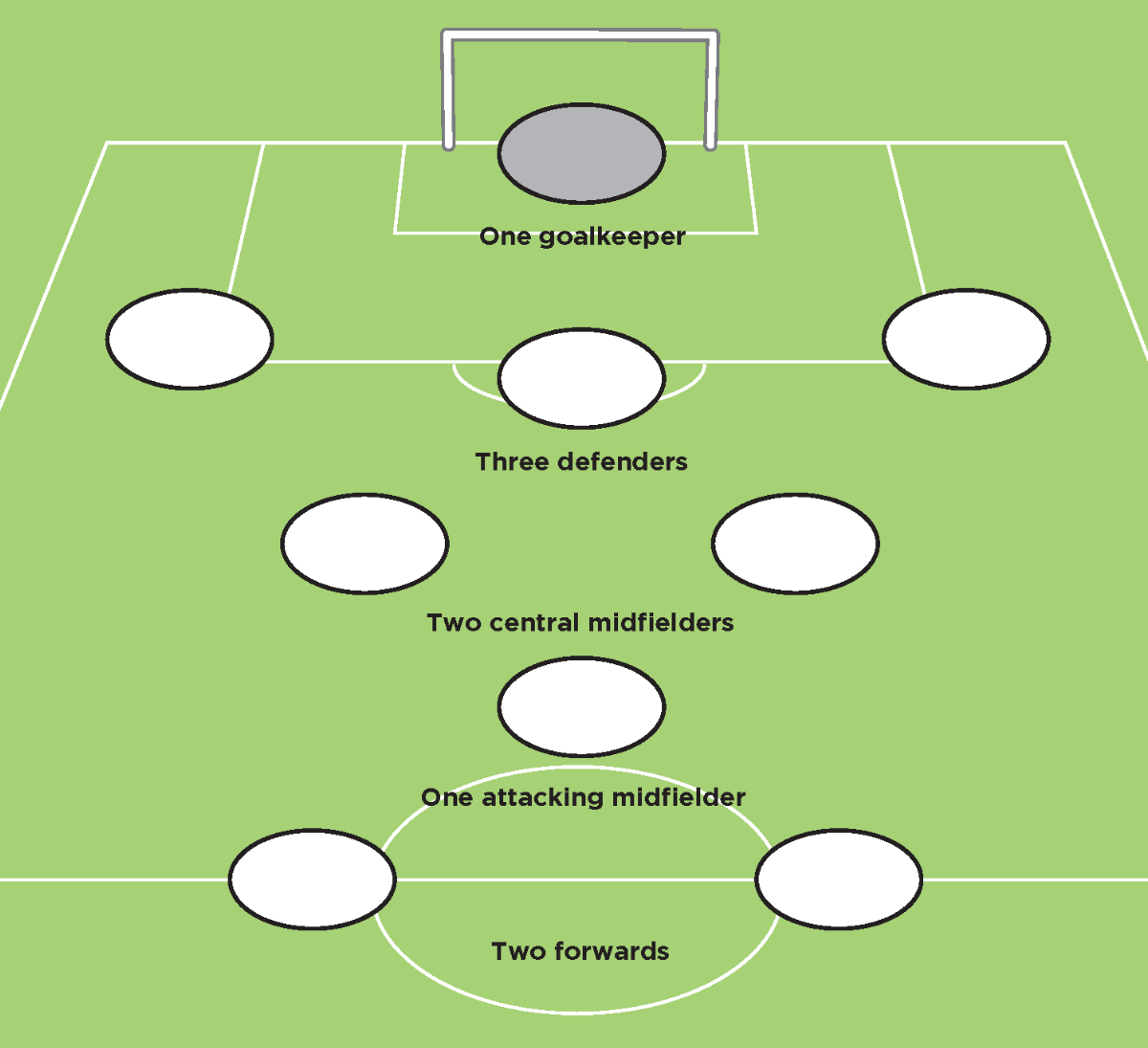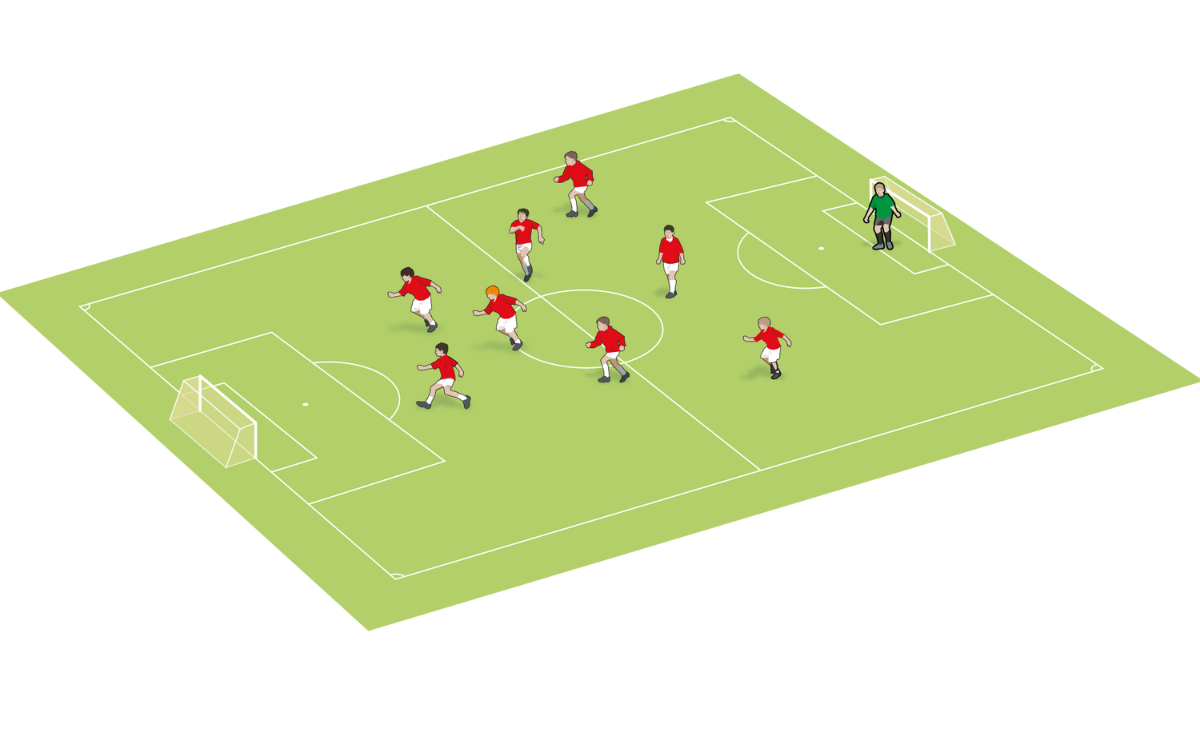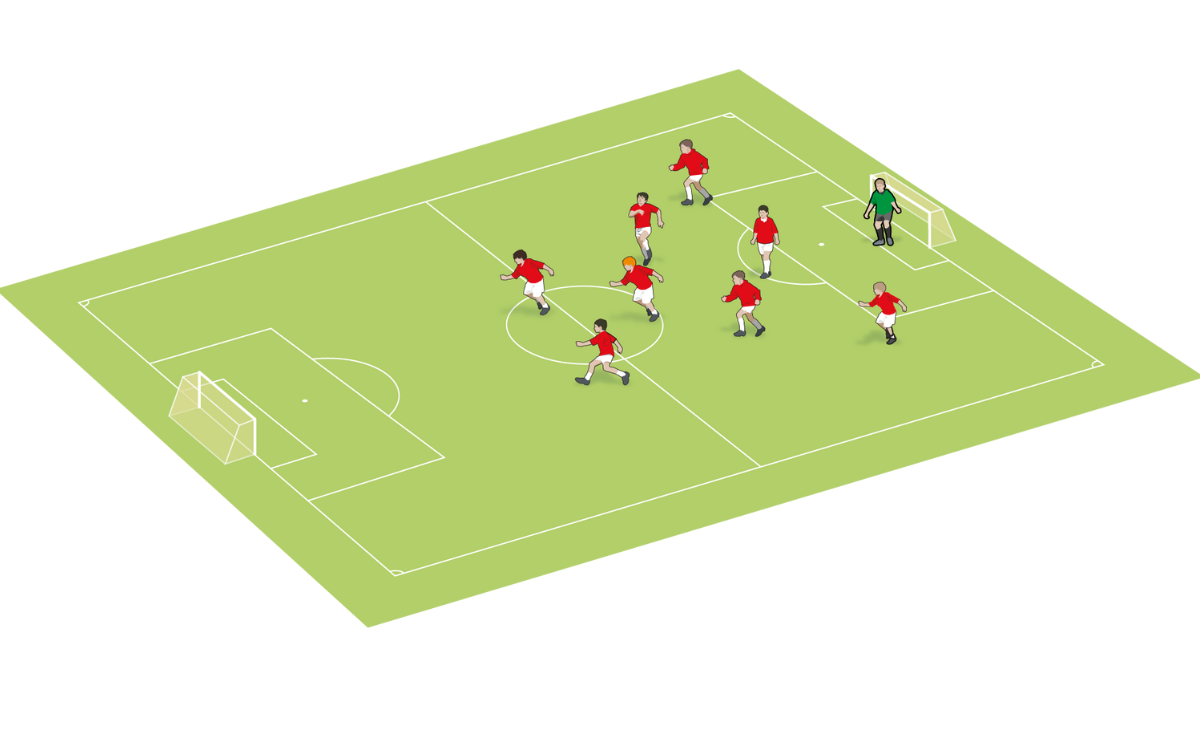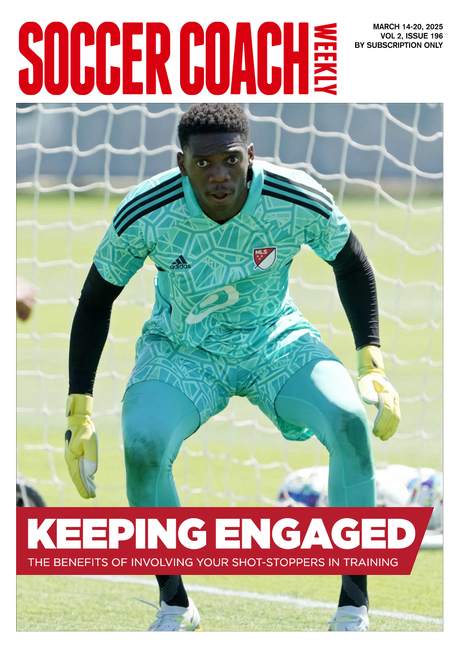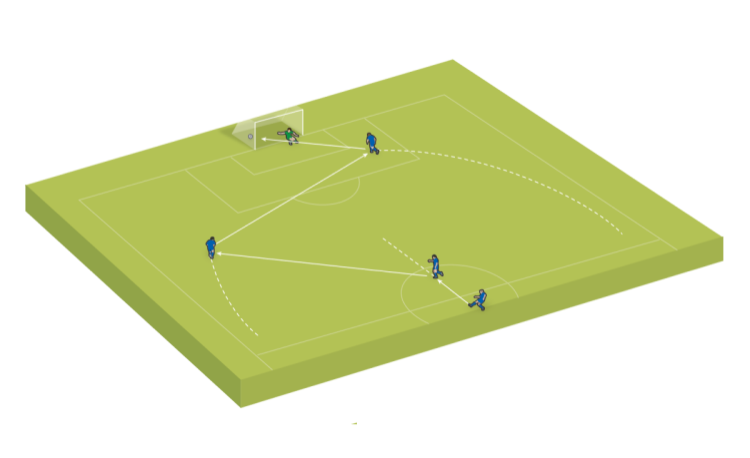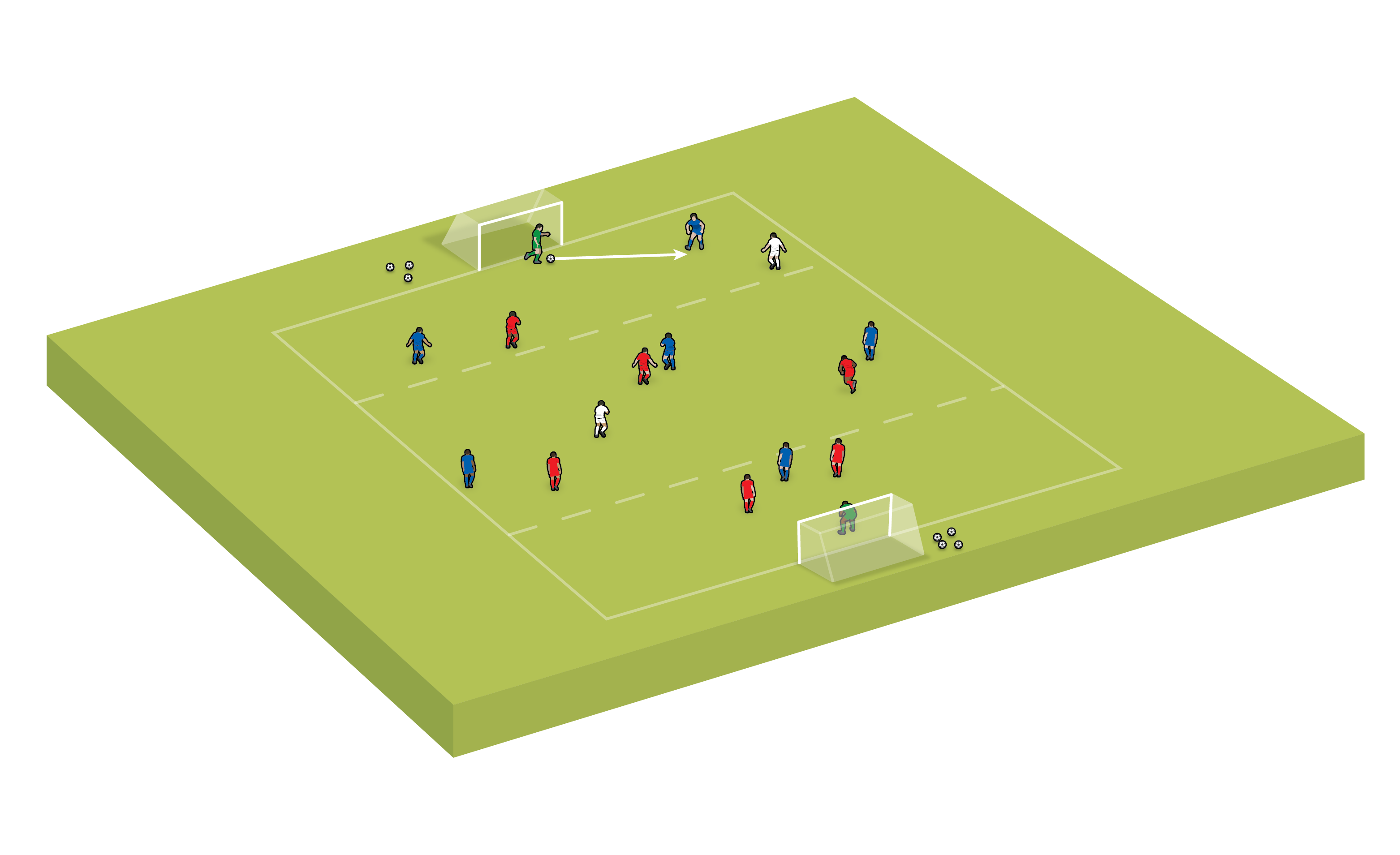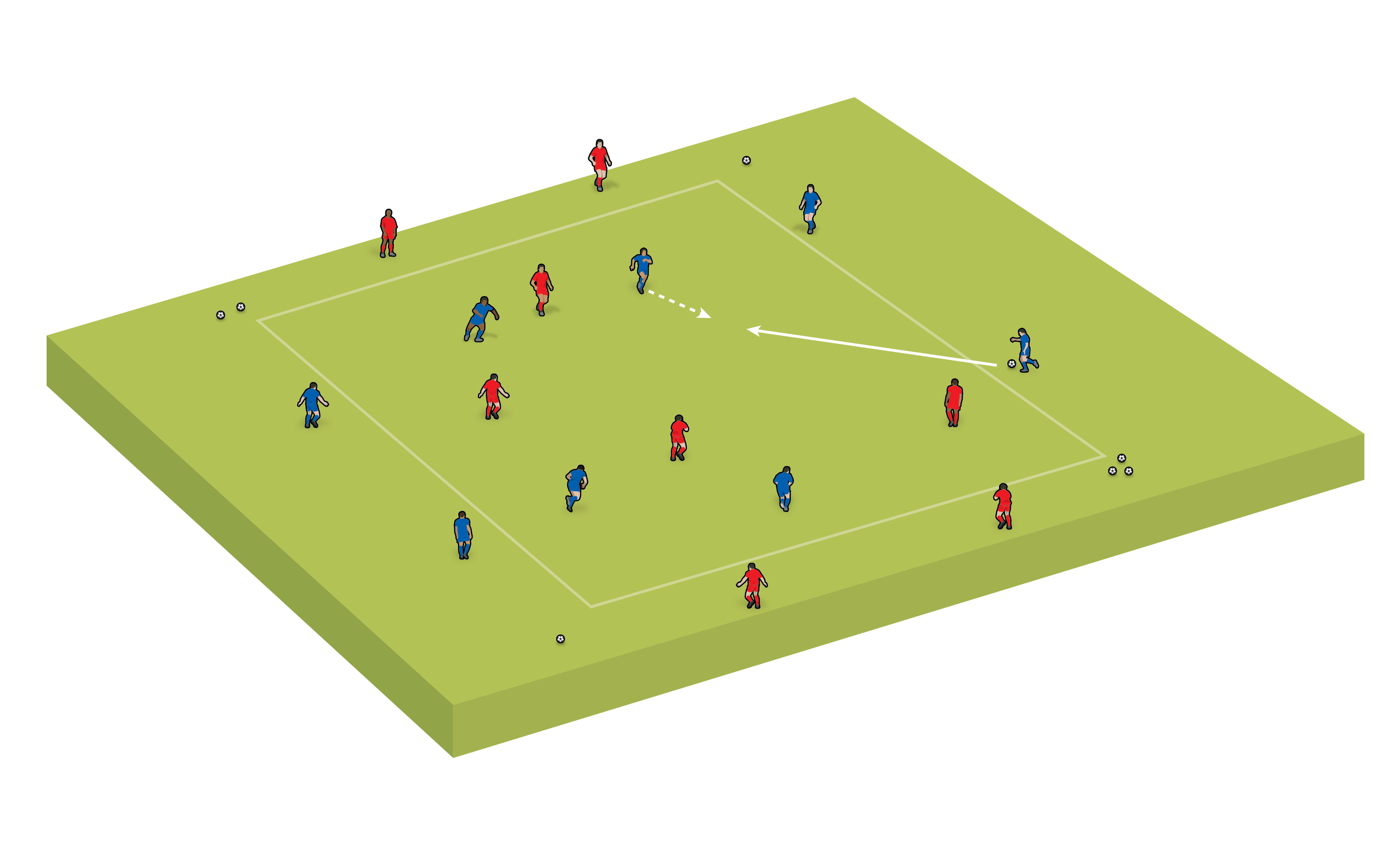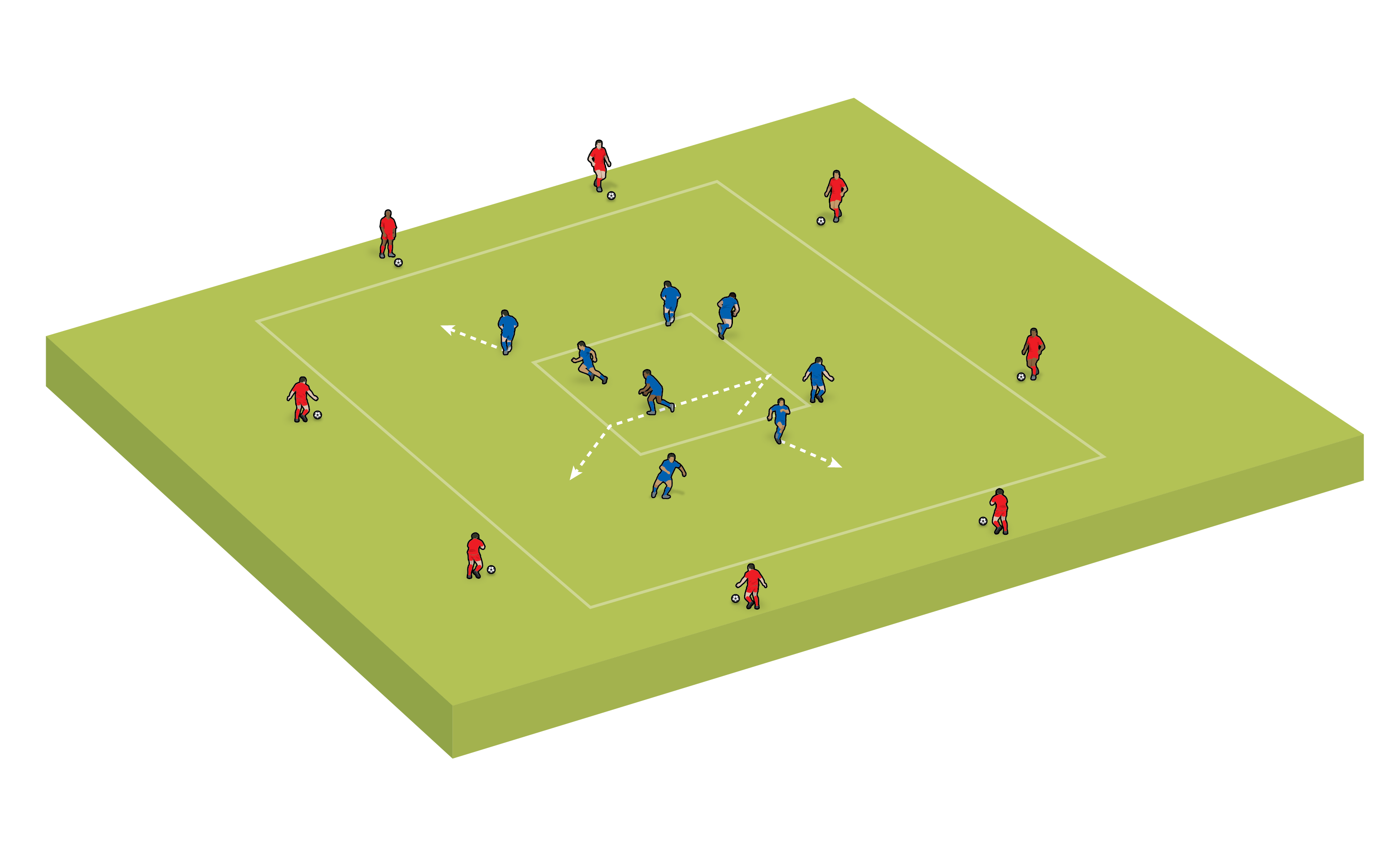9-a-side formation: 3-2-1-2
Why choose this 9v9 formation? Review the pros and cons, in possession and out of possession principles, and each position
Progresses from: 2-2-2 (7-a-side)
Progresses to: 3-5-2 (11-a-side)
PROS OF THIS FORMATION |
CONS OF THIS FORMATION |
|
|
|
|
|
9v9 3-2-1-2 - IN-POSSESSION SUMMARY
IN-POSSESSION PROS |
IN-POSSESSION CONS |
|
|
|
|
|
|
|
3–2-1-2 IN-POSSESSION - BY POSITION
Goalkeeper
When the goalkeeper has possession, they should have a number of passing options available to them.
As well as the back three, the two central midfielders should be able to position themselves in between the central defender and a wide defender, to find space to receive.
This means the goalkeeper has five passing options across the field, and a decision to make about which one to choose. As with all decision-making, it should be done made quickly and accurately, and, once made, committed to.
Of course, opponents will be attempting to cut off these options. Therefore, details about the pass – including its weight and where, specifically, the receiving player wants the ball – will be crucial.
This formation also allows the goalkeeper to be more direct with their distribution.
Though encouraging young players to play out from the back is definitely the right thing to do in terms of their development, it does not mean that this is the only way they should be coached. Goalkeepers can look to play long, If it is the right decision.
This is usually when the front players are in a good position to attack – in other words, they are equally matched against the opposition’s defenders, or even have an overload.
As this formation has two strikers and an attacking midfielder, it is likely that this scenario will occur often. Therefore, there is a good opportunity for the goalkeeper to work on identifying when to play long, as well as their distribution over greater distances.
Central defender
Because of the number of players ahead of them, and next to them, the central defender has a limited role to play when their team has the ball. They are, however, still important.
They must recognise the right passing option that will allow the team to not only retain possession, but to progress forward and move up the pitch.
The key to this is them recognising where the spaces are on the pitch that will allow them, and the team-mate receiving the ball, to progress.
However, there will be times where they are not in a position to play forward. In these circumstances, they need to make sure the team is able to keep the ball – when they do make a pass, they must not put a team-mate in trouble.
The majority of the passes the central defender will receive will be played back to them, providing them with a good opportunity to work on their touch.
Instead of just controlling it and getting it out of their feet, they should look to play it into an area that takes them away from danger and allows them to complete their next action quickly, efficiently and effectively.
Wide defenders
In this formation, the wide defenders are essentially playing as wing-backs when their team has the ball.
To do this successfully, they will need to get themselves into wide areas, and advance up the pitch as the team progresses forward.
They will also have the opportunity to practise driving with the ball and crossing.
These particular techniques are also prevalent in other formations that use three or four defenders, but this one, in particular, encourages the opportunity to combine with team-mates more than any others.
As there are a number of players in central areas, opposition players will also look to occupy these spaces.
Therefore, when the wide defender receives a pass, it is likely they will do so with a good amount of room, with which to move forward with the ball.
When they do so, they will, at some stage, be closed down by an opponent. It is at this moment that they can look to combine with a team-mate.
The majority of their team-mates being positioned inside will give the wide defender an opportunity to combine through a ’wall pass’, also known as a one-two or a give-and-go.
This is where a player passes the ball to a team-mate and runs past a defender to receive the return pass. The timing, weight and area of pass are all key elements of a successful wall pass.
Central midfielders
The two central midfielders need to work on their positioning as a pair.
When playing next to each other in a unit, players will often position themselves next to each other, on the ‘same line’. Being on the same line makes it a lot easier for the opposition to remain compact and a lot harder for the team with the ball to make a penetrating pass.
Therefore, to make it more difficult for opponents to stop them from playing forward, these two midfielders need to be on opposite lines – in other words, one needs to come short and the other goes long.
They will then make that area of the pitch much larger, meaning the opposition players have a bigger area to protect.
To make it even more challenging for the opposition, these two players should keep swapping positions. To do this, the players will need to be aware of their partners movements.
As one player moves from their starting position and towards their partner – so starting ’short’, but then going ’long’ – their partner needs to do the opposite.
Quite often, it will be the player making the second movement who will receive the ball, as the first movement made by the other central midfielder will attract the attention of their opponents.
To help with this, the first player’s movement should be done with loud communication and dynamic action, while the second player’s actions should be more subtle.
Attacking midfielder
The first thing the attacking midfielder will need to consider is where the space is.
With two team-mates positioned directly ahead of them, and two behind them, it would be easy for them to position themselves in congested areas of the pitch.
It is likely that the two strikers will occupy the opposition’s defensive players. This should make it easier for the attacking midfielder to find space between the opposition’s defensive and midfield units.
When they have found the space and received the ball, they will then have another challenge – trying to penetrate the final defensive line and get the ball through to one of the two strikers.
To enable them to do this, it is important that they are decisive in their play, making quick decisions and executing the selected action immediately.
They will need to scan before receiving the ball and, if in space, open their body and receive on the back foot, helping them to see what is ahead of them and play quicker.
If they do not execute the pass quickly enough, it is likely that the player they are looking to play the ball to will be in an offside position by the time the pass has been made.
Forwards
The two forwards can expect to receive through balls to run on to. To do this effectively, it’s important to consider both the timing and area of runs from one, or both, of the strikers.
The strikers must start their run before the pass is made. If they wait until their team-mate plays the ball, this will be too late.
They need to be on the move as their team-mate receives the ball, making sure they stay onside before the pass is made. To do this, they need to recognise when their team-mate is in a position to play the ball.
Forwards shouldn’t make a straight run to receive a straight pass. These types of runs are natural; a player will run forward in a straight line, directly towards the goal.
But, this type of pass and run will often result in the ball running through to the goalkeeper. Therefore, only the pass or the run can be straight; the other one – or both – needs to be diagonal.
9v9 3-1-2-1-1 - OUT-OF-POSSESSION SUMMARY
Related Files
OUT-OF-POSSESSION PROS |
OUT-OF-POSSESSION CONS |
|
|
|
3-2-1-2 OUT-OF-POSSESSION - BY POSITION
Goalkeeper
As with other formations that are heavily weighted towards the central areas, the goalkeeper will need to deal with balls coming in from the wide areas of the pitch.
These crosses will be delivered in various ways, including lofted, driven and cut back.
The ‘keeper is also likely to face shots from wide areas of the penalty box. This gives them an opportunity to work on their positioning, as they try to close down the angle and close off the front post.
Due to the number of players positioned centrally in this formation, opponents will find it difficult to break the team down through the middle.
If they have a lot of the ball in central areas, but are struggling to break through, they will likely shoot from distance, meaning the ’keeper will face various types of shots.
Central defender
As the opposition are likely to look to play around the defence, and put balls into the box from wide areas, the central defender must be able to defend crosses effectively.
They will need to position themselves correctly, and have the correct body shape, so that they can see both the ball coming and the movement of the opposition players.
It is also really important that they are on the front foot, meeting and attacking the ball, rather than waiting for it to reach them. This may include the need to head the ball and clear their lines, rather than trying to keep the ball and taking risks.
It is important to remember that, at this stage of development, we should still encourage players in defensive areas to try and keep the ball where possible, rather than just kick it away.
But the nine a-side format of the game offers players opportunities to develop their decision-making around the right time to get the ball away from dangerous areas of the pitch.
Wide defenders
Because the central areas of the pitch are congested and difficult to play through, the opposition are likely to target the wide defenders.
This means they will need to be really competent at defending in a number of different ways, including defending ‘faced-up’ – going against an opponent who is dribbling and looking to get past them.
They will also find themselves in situations where the ball is played into the space in the wide areas. They will then need to turn and get into a race with the opponent that the ball was intended for.
Depending on the formation of the opposition, there is a possibility the wide defender will find themselves outnumbered in a 2v1 situation.
In these circumstances, they will need to work on their positioning, and delay the opposition until a team-mate is able to come and help.
If the wide defenders are not able to delay the attacker, they should position themselves in order to not overcommit, which can make their opponent’s decision easier.
For example, committing to trying to tackle the player with the ball makes it an easy decision for their opponent to pass it to a team-mate.
Due to the amount of protection that the central defender has around them, there shouldn’t be too much demand for them to be involved in isolated 1v1 situations – if they are, they will most likely be required to defend from behind.
The first thing they need to consider is whether they can win the ball before it even reaches their opponent.
If this is not a possibility, they need to ensure the player with the ball is not able to turn, making sure they get tight to their opponent. However, they should not get too tight, as they could get ’rolled’ – in other words, the player could spin round them.
Central midfielders
A key part of playing as a central midfielder in this formation is being aware of where the ball is located, and reacting as it is moved around the pitch by the opposition.
Should the team, and these two players in particular, remain organised and compact, the opposition are unlikely to try and advance through the centre of the pitch. It is therefore likely that the central midfielders will not need to engage in many 1v1 duals.
The difficulty for these players arises when the ball is played into a wide area and they must make decisions about whether to hold their position or move into this wide area.
They should only leave their position if they are confident that they can affect the opposition, whether this is by winning the ball or preventing them from progressing.
If they do not believe they can do this, it will be more beneficial to the team if they remain in the centre of the pitch.
This is not only because the primary focus of defending is to protect the goal; at some point, the ball will need to come back into the central area of the pitch, whether this is through a pass, a cross or a player travelling with the ball.
Remaining in the centre of the pitch will, therefore, allow the midfielders to help the team defend this dangerous situation.
Attacking midfielder
This player’s out-of-possession role will vary, depending on the formation the other team uses.
For instance, if they play with three midfielders, including a holding midfielder, the attacking midfielder can be given the task of preventing that holding player from getting on the ball, or closing them down when they do have it. This is man-marking.
Learning to man-mark as an attacking midfielder has a number of elements to it.
For instance, a player positioning themselves between their opponent and the ball, thereby closing off the passing line, is a more effective way of stopping an opposition player from getting on the ball than directly marking from behind. The latter is a more effective way of stopping a player from playing forward.
If the opposition are playing a 3-2-3 formation, the attacking midfielder will likely need to push on and help the two strikers close down the back line, so that they can try and win the ball high up the pitch.
This player must, therefore, be able to defend in a number of different ways. Ideally, they will start to work out for themselves what they need to do when their team loses the ball.
This is a lot easier when there is a restart, as they will have time to organise themselves and think about where they are needed.
When there is a moment of transition, this becomes much more challenging and their role is no longer as straight forward, requiring them to put more thinking into where specifically they are needed and what exactly it is they need to do.
Forwards
It is essential that the strikers in this formation work together when defending, otherwise they will lose the advantage that comes with having two players high up the field.
Should one of the strikers not back up their partner, it is likely that the opposition will be able to penetrate the forward line easily, and therefore open up the pitch.
In this striker partnership, it is quite often the player who is not closing down the ball who has the more important part to play in trying to win it back.
At this stage of our players’ soccer development, it can be quite difficult for them to understand where they need to show the opponent on the ball; inside or outside.
We can start to introduce this idea by encouraging them to make their opponent more predictable in their play.
In other words, as they approach their opponent, and once they engage them, they reduce the amount of options that opposition player has.
Making the play predictable then makes it easier for the other striker to work out what the player on the ball is likely to do – because there are fewer outlets available to them.
However, they can only do this if they carefully watch their partner, and the player in possession, to see what they are doing, so that they can predict where the ball is likely to go next.
Once they have done this, they then need to select the best position to place themselves.
They can either look to block the option off completely, increasing the pressure on the player that has the ball. Or, they can try and set a trap by positioning themselves so that the player with the ball thinks their team-mate is still an option.
Once the ball is played, the striker can then either intercept it, or put immediate pressure on the player receiving the pass.
Newsletter Sign Up
Coaches Testimonials

Gerald Kearney, Downtown Las Vegas Soccer Club

Paul Butler, Florida, USA

Rick Shields, Springboro, USA

Tony Green, Pierrefonds Titans, Quebec, Canada
Subscribe Today
Discover the simple way to become a more effective, more successful soccer coach
In a recent survey 89% of subscribers said Soccer Coach Weekly makes them more confident, 91% said Soccer Coach Weekly makes them a more effective coach and 93% said Soccer Coach Weekly makes them more inspired.
*includes 3 coaching manuals
Get Weekly Inspiration
All the latest techniques and approaches
Soccer Coach Weekly offers proven and easy to use soccer drills, coaching sessions, practice plans, small-sided games, warm-ups, training tips and advice.
We've been at the cutting edge of soccer coaching since we launched in 2007, creating resources for the grassroots youth coach, following best practice from around the world and insights from the professional game.
